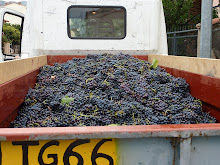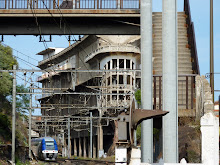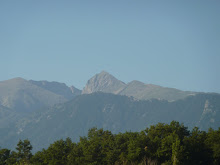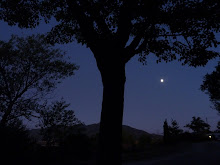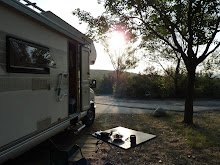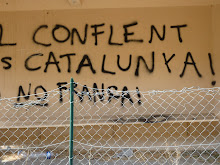Le Boulou/el Vol'o is the surviving "centre of the French cork industry" I read somewhere, the most prominent company Bouchons Trescases. It's a pleasant small town on its convenient crossroads, with a market on Thursdays. It has a 12th century romanesque church, beautifully plain but with fine carvings above the door by le maitre de Cabestany.
1st September After Le Boulou, with a replacement klaxon, a trip further down the coast - over the corniche to Banyuls, where the vendange is under way and small farmers bring trucks of grapes at arranged times to one of several caves in town. One town further -by train by choice - is Cerbere, just north of Port Bou.
Banyuls attracts visitors and has a healthy local economy. Cerbere is pleasant but not thriving, in spite of recent assurances by the Consil General that its mairie is not going to close. The little gravel beach is dominated by a railway viaduct carrying passenger and container traffic over the border, but the railway hotels are run down or closed. Information about rail travel further into Spain than Port Bou is unavailable.
3 September Back over the corniche and out of the Arbere hills to the sharp contrast of Argeles sur Mer, its flat landscape, easy cycling and miles of sandy beach. I stay four nights at the quiet end of the resort, 50m from the beach. This is the beach of La Retirada where tens of thousands of Spanish refugees from Franco arrived in 1939 and large numbers of them died during the first winter. With France herself at war in September, there can't have been many resources to spare for refugees.
By contrast, I find it a good place to pedal or try the sea for the first time, now that La Rentree (to school and work) has suddenly made campsites, roads and resorts quieter.
7 September Restless again, and wishing to add possibilities to my list of sites that stay open after September, I set off north to the smart Perpignan suburb of St Assicle (small site, worn facilities, but kept clean and secure), Salses le Chateau (two good sites) and Leucate, where I stay because it is already afternoon and I like the village, on a small hill between a windy lagoon and the sea.
This is more famous wine country, producing - in ascending order of cost - Fitou, Corbieres and vin de pays. Tractors with small trailers queue up to unload their grapes at the cooperative on the flat top of the hill, and local customers refill their 3 or 5-litre containers from the taps at the (smart) shop on site, which also sells a variety of Fitou/Corbieres/VdP in red, white and rose.
10 September After a drive north to the outskirts of Narbonne to ask about gas, I turn west and stop at Trebes, 6 kms short of Carcassonne by road and 11 by the Canal du Midi. I cycle into Carcassonne along the towpath and back in time for a late dinner lit by the outside light of the neighbouring campers, on the banks of the Aude, on the edge of the Minervois. La Montagne Noire is to the north.
12 September South to Foix again but this time to Camping du Lac. Revisited the best-run second-hand bookshop I've been in, L'ivre Livre.
14 September Mirepoix, also in the Ariege, arriving on market day. The morning provided plenty of interest, but all goes quiet at lunchtime, apparently for the rest of the week. From the town runs the 38 km Cathar route for walkers and cyclists - in reality a disused railway line south.
16 September moved into the Pyrenees again, to the valley above Ax-les-Thermes. Good walking with well marked paths.
17 September Over the top (by tunnel, in fact) to the Cerdagne which I visited once on the yellow train.
18 To Barcelona and back by train for 16 euros. 4 hours available to stroll and have a late lunch/dinner. The line - the trans-Pyrenean railway of the 1920s - has 28 tunnels in as many miles.
Now camped in Bourg Madame until I decide to leave the mountains for the lower valleys and Perpinya again.
